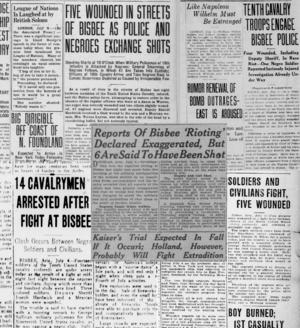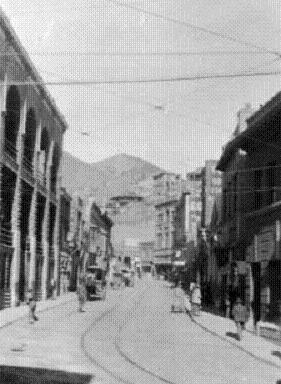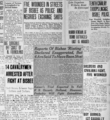Bisbee Riot facts for kids
| Part of Red Summer | |

July 4th US News coverage of the July 3, 1919 Bisbee Riot
|
|
| Date | July 3, 1919 |
|---|---|
| Location | Bisbee, Arizona, United States |
| Also known as | Battle of Brewery Gulch |
| Outcome | ~8 wounded |
The Bisbee Riot, also called the Battle of Brewery Gulch, happened on July 3, 1919. It was a fight between black soldiers from the 10th Cavalry, known as Buffalo Soldiers, and local police in Bisbee, Arizona.
The trouble started when a military policeman and some Buffalo Soldiers had a disagreement. This quickly grew into a street fight in Bisbee's old Brewery Gulch area. At least eight people were hurt, and fifty soldiers were arrested. This event was unusual because it was a conflict between police and military members. Many other similar events during the Red Summer of 1919 involved white civilians fighting against black civilians.
Contents
What Was Bisbee Like in 1919?
In 1919, Bisbee was a town of about 20,000 people. It was home to many different groups, including white, black, Hispanic, Asian, and Native Americans. The town was known for its copper mines. After World War I, the demand for copper went down. This meant many miners lost their jobs.
Bisbee's leaders were known for being tough on miners. Many miners were immigrants or minorities. Officials also tried to stop workers from forming unions.
The Bisbee Deportation of 1917
Two years before the riot, in 1917, Bisbee police and citizens gathered hundreds of miners. They forced these miners onto trains and sent them to New Mexico. This event was called the Bisbee Deportation. Because of this, people in Bisbee were already feeling tense and unhappy. The government was even watching Bisbee officials because of the deportation.
A Town with Strict Rules
Bisbee was a town with strong rules about race. For example, Mexican men were not allowed to work underground in the mines. This higher-paying work was saved for miners from Welsh and Cornish backgrounds.
Chinese immigrants were not allowed to stay in town overnight. Black people could only get low-skilled jobs, like cleaning. In 1919, Fort Huachuca was about 35 miles away. Soldiers from the fort often visited Bisbee. The town's main street had many saloons and places for gambling. It was known as a wild place. This is where the fighting broke out.
Mrs. Frederick Theodore Arnold, whose husband was a fort commander, wrote about Bisbee in her diary in 1918. She described it as a "queerest town" built in a narrow valley. Houses were built on hillsides, "one above the other like the cliff dwellers." She noted it was a "busiest place" with a huge general store.
The Bisbee Riot Begins
On July 3, 1919, soldiers from the 10th Cavalry arrived in Bisbee. They were there to march in the Independence Day parade the next day. The white officers of the regiment went to a dance. The Buffalo Soldiers went to Upper Brewery Gulch, where the Silver Leaf Club was.
Bisbee's Chief of Police, James Kempton, saw many soldiers carrying their automatic pistols. He said they were hidden. Kempton and Officer William Sherrill started taking the weapons from the black soldiers. They told the soldiers they could get their guns back later at the police station.
An officer from the 10th Cavalry spoke to Kempton. He said the military allowed soldiers to carry their guns if Kempton agreed. Kempton said he did not agree. The officer supposedly told his soldiers not to carry weapons. However, some soldiers might not have known or listened.
A Fight and a Posse
Later that night, around 9:30 pm, a white military policeman (MP) named George Sullivan got into a fight. It was with five black soldiers outside the club. Sullivan said the soldiers hit him and took his gun. Other people nearby supported his story.
The soldiers then went to the police station and reported the incident to Chief Kempton. Kempton felt more trouble was coming. He told the soldiers to give up their weapons, but they refused. After the soldiers left, the chief started gathering a group of armed citizens, called a posse. He wanted to "disarm all the negroes they could find."
One person Kempton asked to join was Deputy Sheriff Joseph B. Hardwick. Hardwick had a tough reputation. He had been involved in other shootings before.
Street Battle in Brewery Gulch
The attempt to take weapons from the black soldiers led to a street battle. It happened mainly in Brewery Gulch and lasted over an hour. Some reports say armed white citizens joined the fight. However, other sources say most white people involved were city police or county sheriffs. More than 100 shots were fired.
The fighting stopped around midnight. Fifty Buffalo Soldiers gave up to the police. The remaining soldiers were put on horses. They were told to ride back to their camp in Warren. Two police cars went with them.
Soon after they left, five soldiers who had stayed behind argued with some officers. During this, Deputy Joe Hardwick shot one of the soldiers in the lung.
What Happened After the Riot?
At least eight people were shot or badly hurt. Four Buffalo Soldiers were shot, and two were beaten. A deputy sheriff was seriously injured. A Mexican-American bystander, Teresa Leyvas, was hit in the head by a stray bullet.
The Army's official report said that local officials had planned to make the black soldiers angry. This was so police and deputies would have an excuse to shoot them.
A report from the Bureau of Investigation said that many innocent soldiers were "roughly handled" and "seriously injured." This was mostly because of Deputy Sheriff Joe Hardwick. The report said he "almost completely lost his head."
No Punishment for Soldiers
None of the Buffalo Soldiers were seriously punished by the Army for the fighting. The 10th Cavalry was allowed to march in the Independence Day parade. White US cavalrymen watched them closely to prevent more trouble. The Buffalo Soldiers later returned to Fort Huachuca. The events of July 3 did not greatly change their lives.
The Bisbee fighting was reported across the country. It showed America's mixed feelings about black soldiers after World War I. White people wanted black loyalty but often did not trust them.
Joe Hardwick faced criticism for his actions. He later moved to Tombstone, Arizona. He continued to work in law enforcement in Arizona for many years. He even became Chief of Police in Calexico, California. His career as a lawman ended after he shot and wounded an unarmed produce dealer.
Images for kids
See also
 In Spanish: Distubios raciales de Bisbee de 1919 para niños
In Spanish: Distubios raciales de Bisbee de 1919 para niños




